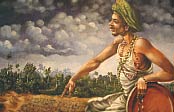The waters at Diamond Falls drop 1,000ft (304m) from the volcano, where they leave the ground at 106 F (41 C).
 |
|||
 |
 |
 |
 |
The Caribbean region is very controversial, even nowadays, after numerous researches. Its ethnical, linguistic and religious plurality makes it heterogeneous and, at the same time, its people’s common history makes it special within the American continent.
The Caribbean was the stage for the "discovery" or "meeting" between two worlds that, so far, had not been in touch. The combination of cultures that converged in this region: European, African and indigenous, brought about a constant assimilation and loss of cultural values. Thus, each territory took its own patterns according to the rate of native population that interacted with cultural elements from different European metropolis: Spain, France, England and Holland, and various African ethnic groups.
Slave trade was one of the most scornful trade activities created by the colonization, which caused the feeling of being separated from one’s roots suffered by nearly 15 million Africans from different ethnic groups. Yoruba,
lucumi, bantu, mandinga, arara, mina, fanti, fon, mayombe, among others, arrived in the New World. Each of them carried their customs, idiosyncrasy, language and religion, which were re-contextualized based on the religious conscience and new environment faced by these men whose culture had been taken away.
In 1685, under Code Noir’s law – after a short period, slaves should be indoctrinated and baptized on catholic faith – African slaves were not allow carrying out their religious celebrations, what forced them to keep these events in secret: the religion became an arcane worship; believers turned into conspirators; sacred meetings into rebellion cells.
However, African-rooted cultural expressions are currently present among us as they were orally transmitted from generation to generation: music, dance, language remainders, culinary customs and religion, they are all part of the Caribbean identity, if we take into account the culture-combination processes suffered in this region.
Specifically, regarding to the religion –understood as unified system of sacred practices and believes -, analogies among indigenous, Hispanic and African religious elements, favored this constant interchange, which brought about a new religiousness that has varied according to the context and status of its churchgoers in different ages. These similarities caused the loss of some features, the acquisition of other and emergence of new components, considering that men are more conservative in terms of religion than any other field. On the other hand, the evangelizing process in Europe couldn’t eliminate African-rooted animistic practices and pagan believes, which somehow contributed to the strengthening of some religious conceptions.
Caribbean popular religions – to be distinguished from ecclesiastical – are characterized for their relation with daily life and people’s problems and culture. Blending of Catholicism with Indian-American or African worships are found in them: the presence of festive elements, myth and superstition; peregrinations and images; ex-votes and promises, as well as utilitarian character.
Thus, different religious expressions can be mentioned in the Caribbean: Regla de Osha, Regla Conga or Palo Monte, Spiritualism, Voodoo, Abakua, Chango Worship, Maria Lionza Worship, Rastafaris, Shouters, among others.

The waters at Diamond Falls drop 1,000ft (304m) from the volcano, where they leave the ground at 106 F (41 C).